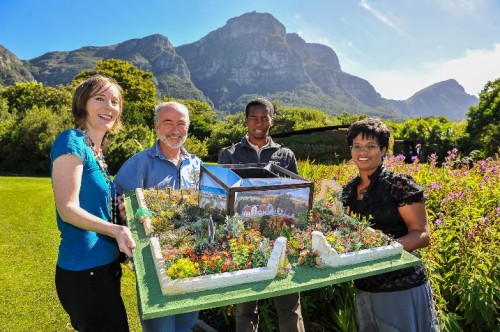
SA Kirstenbosch Chelsea Flower Show Exhibit
Exhibit takes us on a Journey through our diverse botanical heritage Gateways – a botanical journey is the theme for the 2012 South African National Biodiversity Institute’s (SANBI) Kirstenbosch – South Africa exhibit to the prestigious Royal Horticultural Society (RHS) Chelsea Flower Show taking place in London from 22 to 26 May. This will […]

Exhibit takes us on a Journey through our diverse botanical heritage

Gateways – a botanical journey is the theme for the 2012 South African National Biodiversity Institute’s (SANBI) Kirstenbosch – South Africa exhibit to the prestigious Royal Horticultural Society (RHS) Chelsea Flower Show taking place in London from 22 to 26 May.
This will be the 37th year of South Africa exhibiting at the “Olympics” of Flower Shows and hopes are high for winning yet another Gold award.
Our unique flora is a draw card at every Chelsea Flower Show and visitors flock to see the unusual and exotic plants that have seen the Kirstenbosch SA exhibit win year after year. This year promises to be even more attractive as designers David Davidson and Ray Hudson have once again created an innovative design showcasing our diverse floral heritage. Taking the visitor on a journey across the country, the exhibit allows the traveller to experience different destinations that also feature aspects of our cultural heritage.
Just as nature has inspired this year’s exhibit so has the cultural diversity of the South African people, creating an intriguing combination of rich botanical biodiversity and iconic architectural elements; glimpses into the land in which we live. The exhibit takes the visitor on a journey through changing botanical and cultural landscapes, presented as an illustrated travelogue, using watercolour paintings of picturesque locations to set the scene.
The exhibit – rather like the diary of a traveller – documents scenic attractions (both botanical and cultural) of the south-western Cape coast and interior (Fynbos biome) extending into Namaqualand and the semi-arid Karoo (Succulent Karoo biome) and onward to the northern provinces of KwaZulu-Natal and Mpumalanga (Grassland biome).
The artworks will form framed backdrops, with the flora of the various biomes being brought to life in the accompanying landscape displays. These will be interspersed with complementary cut-outs – rather like a pop-up storybook – illustrating architectural and cultural iconic elements from each location. The exhibit is enclosed in a low perimeter wall, with each side featuring a typical architectural gateway providing a ‘sense of arrival’ at each destination. The roads travelled take in a gracious Cape Dutch Manor House here, a fisherman’s cottage there, a rough Karoo farm track towards mountains and an Ndebele (traditional tribal design) archway – just some of the illustrations that invite the viewer onwards.

Since tourism is a major focus of our exhibit at this prestigious show, the inspiration and appeal of the stand has led, in the past, to many more visitors enjoying a visit to South Africa, thus providing much needed jobs. This exhibit creates an even wider panorama of what the traveller can expect.
For the second year the South African Gold Coin Exchange is the major sponsor of the exhibit, allowing the team to put all their energy into creating yet another award-winning exhibit for the country.
Chairman of the SA Gold Coin Exchange and the Scoin shops, Alan Demby, is delighted at the synergies that being a sponsor has brought.
“As a sponsor of last year’s exhibit, we were delighted that the team won yet another RHS Gold Medal at Chelsea. We also learned that a Strelitzia at Kirstenbosch is named after Nelson Mandela with the moniker Mandela’s Gold. This has reinforced our commitment and sponsorship to the Kirstenbosch attempt to win even more gold medals.” he said.
“We are launching a limited edition Gold Mandela medallion featuring the portrait of Mandela on the obverse and the Strelitzia on the reverse. Let’s hope that this will create as much awareness of South Africa’s flora and fauna as Mandela has done for numismatics in South Africa.”
Dr Tanya Abrahamse, CEO of the South African National Biodiversity Institute (SANBI) is enthusiastic about this year’s exhibit. “Biodiversity is our natural capital it is the extraordinary variety of life, such as plants, animals and insects that are the foundation of ecosystems which provide people with benefits. From ecosystems we derive essential goods and services, such as food, water grazing, pollination, fish and medicines. Our ecological infrastructure is an extremely valuable national asset, and we embrace the opportunity Chelsea affords us to highlight this”.
Plants are sourced from all over the country making this a combined effort from both farmers and landscapers who take pride in participating at this prestigious event. Community projects are also represented to ensure that local programmes benefit from their inclusion.
Says David Davidson, “The importance of this exhibit for South Africa cannot be stressed enough – we have the chance to show the world why they should be visiting our country and the widely differing variety of landscapes we hope will spur people on to come and the see the “real thing”.
The featured areas will show the gateway to Africa, the Cape Floristic Region of the south-western Cape, with its bounty of the ever-popular protea family. The display includes as wide an array of fynbos species as possible – depending on flowering times and availability. Featured will be many members of the Proteaceae – numerous protea species as well as cultivars and new hybrids, leucadendrons (cone bushes), leucospermums (pincushions) if available, Pagoda plants (Mimetes) and serrurias (Blushing Bride).
Other important components of the fynbos community are also featured, such as brunias, heaths (Erica), restios and ‘slangbos’ (Stoebe), together with numerous perennial and annual species – many familiar to English gardeners – such asNemesia, Lobelia, Osteospermum, Helichrysum, Felicia, Arctotis and Gazania, and a variety of bulb species.
The Succulent Karoo scene features vegetation typical of the more arid parts of the country including many succulent and aloe species. Firing the imagination the backdrop is the perfect frame for this region. The vegetation is dominated by dwarf, succulent shrubs, of which the vygies (Mesembryanthemaceae) and stonecrops (Crassulaceae) are particularly prominent. Succulent plant species with thick, fleshy leaves are plentiful here, the diversity of which is unparalleled anywhere else in the world for an arid area of this size.
The Grassland is a complex ecosystem, including rivers and wetlands, where only one in six plant species are actually grasses, with the bulk being bulbous plants such as arum lilies, orchids, red-hot pokers, watsonias, gladioli and ground orchids. The Grassland Biome has an extremely high biodiversity, second only to the Fynbos Biome. Rare plants are often found in the grasslands, especially in the escarpment area. The scenic splendour of the escarpment region attracts many tourists.
Over the past 36 years the SA exhibit has notched up 31 Gold medals, two Silver-Gilt medals and three Silver medals, as well as numerous other special awards for outstanding contributions, including the Lawrence Medal in 2006 for the ‘Best Exhibit shown to the Society’ in that year and was the first recipient of the new ‘President’s Most Creative Award’ in 2008. The display is project managed by Sarah Struys, Events Manager at Kirstenbosch with the designers and a team from SANBI: Alison Pekeur, Kuphumla Zenze from Kirstenbosch and Mondisa Kondlo from Walter Sisulu National Botanical Garden in Johannesburg. Enthusiastic volunteers from South Africa make their way to London to assist making the exhibit a truly passionate South African project.
Ends
Issued on behalf of SANBI by HIPPO Communications
For further information please contact Beryl Eichenberger: 021 556 8200 /082 490 6652
Editor’s notes
THE FYNBOS BIOME
The Fynbos Biome is synonymous with the Cape Floristic Region or Cape Floral Kingdom. However, the Biome refers only to the two key vegetation groups (Fynbos and Renosterveld) within the region.
Fynbos is characterised by the presence of the following three elements: Restios, belonging to the Restionaceae or the Cape Reed Family; Ericas or heaths and Proteas which are the dominant overstorey in Fynbos. Fire is a major influence on Fynbos community processes. Fynbos must burn at between 6 and 45 years of age in order to sustain its plant species. Many species store their fruit in fire-safe cones for release after a fire, and ants are enticed to bury fruit where they are safe from rodents and fire and can regenerate. Without fire, Fynbos becomes senescent and surrounding vegetation types begin invading.
Some three-quarters of all plants in the South African Red Data Book occur in the Cape Floral Kingdom: 1 700 plant species are threatened to some extent with extinction!
Renosterveld is characterised by the dominance of members of the daisy family (Asteraceae), as well as a high species richness of geophytic or bulbous plants (chiefly in the iris family (lridaceae) and lily family (Liliaceae), but also in the orchid family (Orchidaceae).
THE SUCCULENT KAROO BIOME
The succulent Karoo is restricted to the year-round and winter rainfall areas with the greatest summer aridity. This biome occurs mostly through the western belt of the Western Cape and inland towards the Little Karoo.
The vegetation is dominated by dwarf, succulent shrubs, of which the vygies (Mesembryanthemaceae) and stonecrops (Crassulaceae) are particularly prominent. Succulent plant species with thick, fleshy leaves are plentiful here, the diversity of which is unparalleled anywhere else in the world for an arid area of this size. This, together with many geophytes (plants that survive by means of bulbs, tubers, etc. in times of unfavorable climatic conditions) and annual plants, makes the succulent Karoo unique and of international importance in terms of conservation.
This is also the land of many spring flowers, which for a few weeks each year, draw large numbers of tourists from all over the world who come to enjoy the coastal scenery and the spring mass flower displays.
THE GRASSLAND BIOME
Grasslands are dominated by a single layer of grasses. Trees are absent, except in a few localized habitats. Geophytes (bulbs) are often abundant. Frosts, fire and grazing maintain the grass dominance and prevent the establishment of trees.
The term ‘grassland’ creates the impression that the biome consists only of grass species. In fact, it is a complex ecosystem, including rivers and wetlands, where only one in six plant species are grasses, with the bulk being bulbous plants such as arum lilies, orchids, red-hot pokers, watsonias, gladioli and ground orchids.
The Grassland Biome has an extremely high biodiversity, second only to the Fynbos Biome. Rare plants are often found in the grasslands, especially in the escarpment area. Very few grasses are rare or endangered. The scenic splendour of the escarpment region attracts many tourists.
